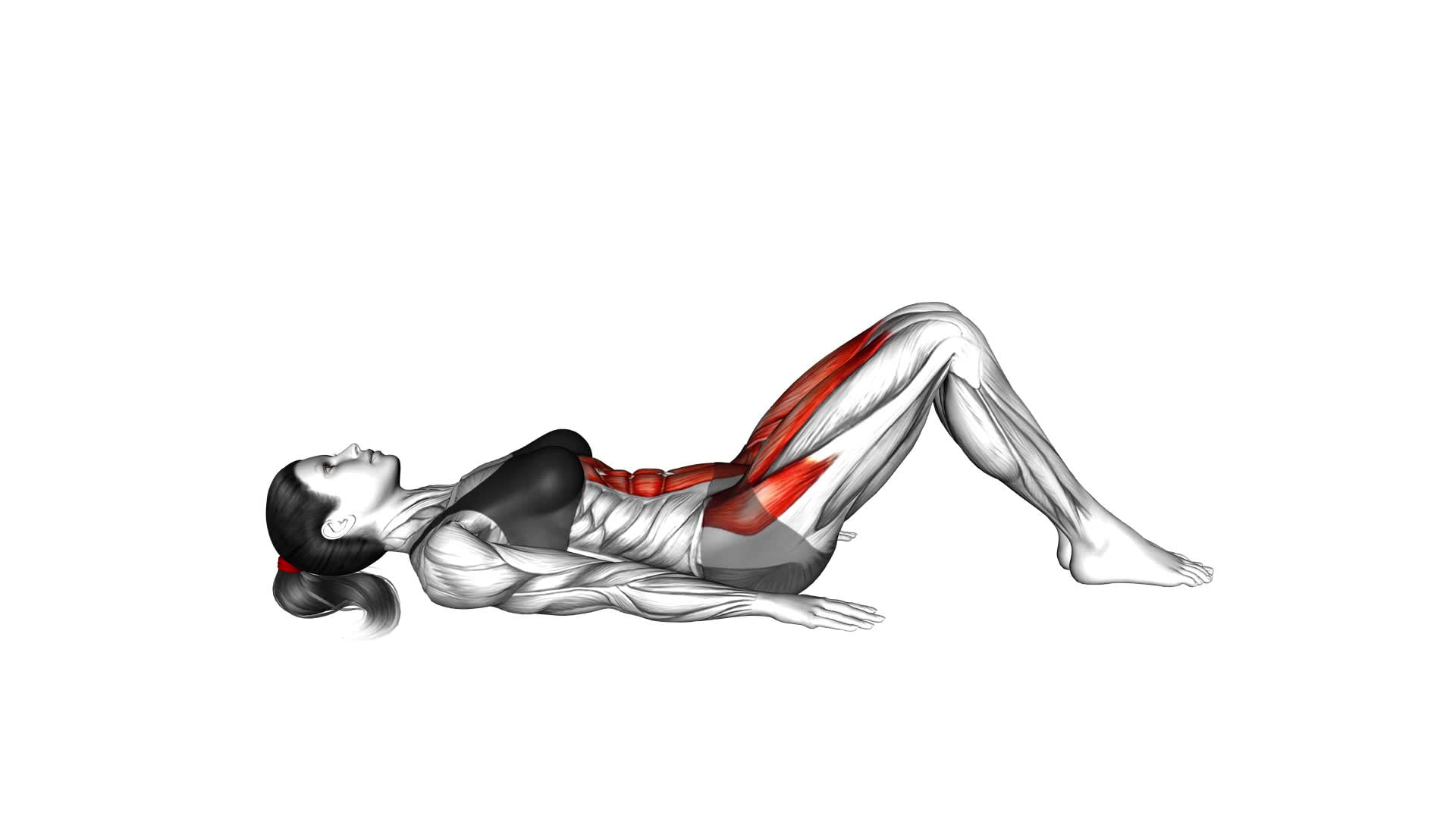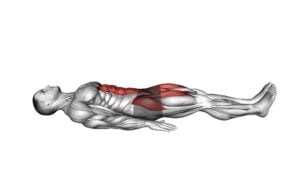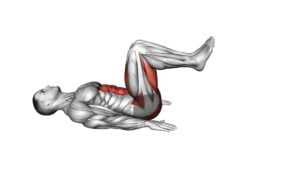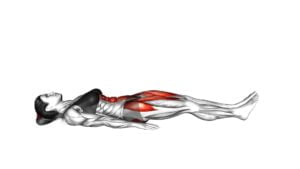Lying Leg Extension (female) – Video Exercise Guide & Tips

Looking to strengthen your legs and tone your muscles? Check out this video exercise guide for lying leg extensions.
Watch This Exercise Video
In this guide, we'll walk you through the proper set-up and equipment, provide step-by-step instructions for correct form, offer variations to target different leg muscles, and share tips for maximizing your results.
Don't miss out on this effective workout that can help you achieve your fitness goals. Let's get started!
Key Takeaways
- Lying leg extensions strengthen leg muscles and target quadriceps and hamstrings.
- Proper machine adjustments and safety precautions are important for performing the exercise safely and effectively.
- Maintaining proper form and following a step-by-step guide is crucial for maximizing the effectiveness of the exercise.
- Varying foot positions and avoiding common mistakes can help maximize results and prevent injury.
Benefits of Lying Leg Extensions
If you want to strengthen your leg muscles, you can benefit from lying leg extensions. Lying leg extensions are a type of resistance training exercise that specifically targets the muscles in your legs, including your quadriceps and hamstrings. This exercise involves lying flat on your back with your legs extended and lifting your feet towards the ceiling. By doing this, you engage your leg muscles and activate them to perform the movement.
One of the key benefits of resistance training, like lying leg extensions, is that it helps to build and strengthen your muscles. When you perform leg extensions, you're placing a resistance on your leg muscles, which forces them to work harder. This increased workload leads to muscle growth and development over time. Additionally, by targeting specific muscles in your legs, such as your quadriceps, you can improve the overall strength and stability of your lower body.
Another advantage of lying leg extensions is the muscle activation they provide. This exercise directly targets your quadriceps, which are the muscles located in the front of your thighs. By engaging and activating these muscles, you can improve their strength and endurance. This can be particularly beneficial for athletes or individuals who participate in activities that require strong leg muscles, such as running or jumping.
Proper Set-Up and Equipment
To ensure a successful lying leg extension exercise, it's crucial to make correct machine adjustments. Take the time to adjust the seat and footpad according to your body's dimensions and comfort.
Additionally, always prioritize safety by following the machine's guidelines and taking necessary precautions. Remember, maintaining proper form throughout the exercise is essential for targeting the correct muscles and preventing potential injuries.
Correct Machine Adjustments
Make sure you're properly adjusting the machine and equipment before beginning the lying leg extension exercise. Proper machine adjustments are crucial to ensure that you're targeting the correct muscles and performing the exercise with proper form. Start by adjusting the seat height so that your legs are at a 90-degree angle when your knees are bent.
Then, adjust the backrest so that it supports your lower back. Make sure the footpad is positioned comfortably on the top of your feet, just above your ankles. By making these adjustments, you'll be able to perform the exercise safely and effectively.
Now that you have set up the machine correctly, it's time to discuss safety precautions and guidelines.
Safety Precautions and Guidelines
Before starting the lying leg extension exercise, ensure that you have set up the equipment and made the proper adjustments for your safety and effectiveness.
To prevent injuries and maximize the benefits of this exercise, it's crucial to follow some safety precautions and guidelines.
First, it's recommended to warm up your muscles with some light cardio exercises or dynamic stretches. This will increase blood flow and prepare your muscles for the workout.
Additionally, be sure to check that the machine is properly adjusted to fit your body size and comfort level. Adjust the seat height so that your knees are aligned with the machine's pivot point.
Lastly, always maintain proper form and technique throughout the exercise to avoid strain or injury.
Importance of Proper Form
Ensure that you properly set up the equipment and adjust it to your body size and comfort level to maintain proper form and maximize the effectiveness of the lying leg extension exercise. The importance of technique can't be stressed enough when performing this exercise. Proper form ensures that you're targeting the correct muscles and minimizing the risk of injury.
One common form error to avoid is using momentum to lift the weight. Instead, focus on using controlled movements and engaging your quadriceps to lift the weight. Another common mistake isn't fully extending your legs at the top of the movement. Make sure to straighten your legs completely to fully engage your quadriceps.
Step-by-Step Guide for Correct Form
To perform the lying leg extension exercise with proper form, ensure that your body is positioned correctly and your muscles are engaged throughout the movement. This will help prevent common mistakes and maximize your results.
Start by lying flat on your back on an exercise mat or bench, with your legs extended and your feet flexed. Place your hands palms-down beside your body for support. Engage your core muscles by drawing your navel towards your spine.
Next, slowly lift one leg off the ground, keeping it straight and parallel to the floor. Continue lifting until your leg is fully extended, but be careful not to lock your knee joint. Hold this position for a moment, then slowly lower your leg back down to the starting position.
Repeat the movement with the other leg, alternating between legs for the desired number of repetitions. Remember to keep your movements controlled and avoid any swinging or jerking motions.
Variations to Target Different Leg Muscles
To target different leg muscles with the lying leg extension exercise, you can vary your foot position and focus on either your hamstrings or quadriceps.
By pointing your toes inward, you'll engage more of your inner thigh muscles and hamstrings.
Conversely, pointing your toes outward will target your outer thigh muscles and quadriceps.
Hamstring Vs Quadriceps
For targeting different leg muscles, you can vary your exercises to focus on either the hamstrings or quadriceps.
Hamstring activation is important for overall lower body strength and stability, as well as preventing injuries. Many people have quad dominance, meaning their quadriceps muscles are much stronger than their hamstrings.
To specifically target the hamstrings, you can perform exercises such as hamstring curls, Romanian deadlifts, or glute bridges. These exercises isolate and activate the hamstrings, helping to balance out the strength between the hamstrings and quadriceps.
By incorporating these exercises into your workout routine, you can improve hamstring strength and reduce quad dominance.
Now, let's move on to the next section where we'll discuss the impact of different foot positions on targeting specific leg muscles.
Different Foot Positions
Now let's explore how different foot positions can be used to target specific leg muscles, building upon the previous discussion on hamstring and quadriceps activation.
By adjusting the position of your feet during the lying leg extension exercise, you can effectively engage different leg muscles.
Placing your toes inward targets the inner thigh muscles (adductors), while pointing your toes outward emphasizes the outer thigh muscles (abductors).
If you position your feet with your toes pointing upward, you'll primarily engage your quadriceps. Conversely, pointing your toes downward will place more emphasis on your hamstrings.
It's important to vary your foot positions to ensure balanced muscle development and prevent muscle imbalances.
Now let's move on to the next section to learn about common mistakes to avoid during the lying leg extension exercise.
Common Mistakes to Avoid
Avoiding these common mistakes during the lying leg extension exercise will help you maximize your results and prevent injury. Here are some key mistakes to avoid:
- Using momentum: One common mistake is using momentum to lift your legs instead of relying on your muscles. This not only reduces the effectiveness of the exercise but also increases the risk of injury. Focus on controlled movements and engage your muscles throughout the entire range of motion.
- Lifting too heavy: Beginners often make the mistake of choosing weights that are too heavy for them. This can strain the muscles and joints, leading to injuries. Start with lighter weights and gradually increase the resistance as your strength improves.
- Arching your back: It's important to maintain proper form during the exercise. Avoid arching your back as it can put unnecessary stress on your spine. Keep your core engaged and your back flat against the bench throughout the movement.
- Neglecting proper breathing: Breathing correctly during the exercise is crucial. Many people hold their breath or exhale at the wrong time, which can hinder performance and increase the risk of injury. Inhale as you lower your legs and exhale as you lift them.
Tips for Maximizing Results
To maximize your results during the lying leg extension exercise, it's important to incorporate these tips into your workout routine. By following these guidelines, you can maximize gains and make the most out of this exercise.
Firstly, focus on proper form. It's crucial to maintain a controlled movement throughout the exercise. Avoid using momentum or swinging your legs to lift the weight. Instead, engage your quadriceps muscles and lift the weight using a slow and controlled motion.
Secondly, consider adjusting the weight and repetitions. To maximize gains, challenge yourself by increasing the weight gradually. However, ensure that you can maintain proper form while lifting the weight. Additionally, vary the number of repetitions you perform. Mix up your routine by incorporating both high and low repetitions to target different muscle fibers effectively.
Lastly, don't be afraid to make exercise modifications. If you find the lying leg extension too challenging or uncomfortable, consider alternative exercises such as squats or lunges. These exercises engage similar muscle groups and can be just as effective in maximizing gains.
Frequently Asked Questions
Can Lying Leg Extensions Help With Weight Loss?
Lying leg extensions are a great addition to your leg workout routine, whether you're looking to lose weight or not. Compared to other leg exercises, they specifically target your quadriceps, helping to tone and strengthen those muscles.
While they may not directly contribute to weight loss on their own, incorporating them into a well-rounded exercise program can help you build lean muscle mass, which can boost your metabolism and aid in weight loss efforts.
Are Lying Leg Extensions Safe for People With Knee Injuries?
Lying leg extensions can be a beneficial exercise, but it's important to consider safety if you have knee injuries.
There are alternatives to lying leg extensions that can still engage your leg muscles without putting strain on your knees.
It's always best to consult with a healthcare professional or a certified trainer to determine the safest exercises for your specific condition.
They can provide guidance and recommend exercises that will help you achieve your fitness goals while minimizing the risk of further injury.
How Often Should Lying Leg Extensions Be Performed for Optimal Results?
To achieve optimal results from lying leg extensions, it's important to consider the frequency of performing this exercise. Lying leg extensions can be beneficial for strengthening the quadriceps muscles and improving lower body stability. However, overdoing it can lead to strain or injury.
It's generally recommended to perform lying leg extensions 2-3 times a week, allowing for adequate rest and recovery between sessions. This frequency will help you maximize the benefits while minimizing the risk of overexertion.
Can Lying Leg Extensions Help Improve Flexibility?
Lying leg extensions can indeed help improve flexibility. By targeting the muscles in your legs, this exercise helps to stretch and lengthen them, increasing their range of motion. This is beneficial for activities that require good flexibility, such as dancing or martial arts.
Additionally, by strengthening your leg muscles, lying leg extensions can also prevent muscle imbalances, which can lead to injuries. Incorporating this exercise into your routine can contribute to overall muscle strength and flexibility.
Are Lying Leg Extensions Suitable for Beginners?
Lying leg extensions can be suitable for beginners as long as you focus on proper form. However, if you're looking for alternatives, there are other exercises that can target the same muscle groups. Remember to start with a weight that challenges you but allows you to maintain proper form throughout the movement.
Take it slow and gradually increase the weight as you build strength and confidence. Consult with a fitness professional for personalized guidance.
Conclusion
In conclusion, lying leg extensions are a beneficial exercise for targeting and strengthening the leg muscles.
By following proper form and using the right equipment, you can maximize your results and avoid common mistakes.
Remember to start with lighter weights and gradually increase the intensity to avoid injury.
With consistency and proper technique, you can achieve stronger and more toned legs.

Author
Years ago, the spark of my life’s passion ignited in my mind the moment I stepped into the local gym for the first time. The inaugural bead of perspiration, the initial endeavor, the very first surge of endorphins, and a sense of pride that washed over me post-workout marked the beginning of my deep-seated interest in strength sports, fitness, and sports nutrition. This very curiosity blossomed rapidly into a profound fascination, propelling me to earn a Master’s degree in Physical Education from the Academy of Physical Education in Krakow, followed by a Sports Manager diploma from the Jagiellonian University. My journey of growth led me to gain more specialized qualifications, such as being a certified personal trainer with a focus on sports dietetics, a lifeguard, and an instructor for wellness and corrective gymnastics. Theoretical knowledge paired seamlessly with practical experience, reinforcing my belief that the transformation of individuals under my guidance was also a reflection of my personal growth. This belief holds true even today. Each day, I strive to push the boundaries and explore new realms. These realms gently elevate me to greater heights. The unique combination of passion for my field and the continuous quest for growth fuels my drive to break new ground.



